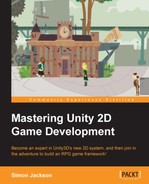The world would be a lonely place if we were alone. So, in this chapter, we'll look to add in some more characters and give them something to say.
There are a few more fair technical solutions that Unity has under its belt; some are just programing-orientated, whereas some are specific to Unity. So, we'll go through each one of them and explain their pros and cons; plus, we'll look at some extensions that we can add to make them even better.
The list of topics that will be covered in this chapter are as follows:
- Advanced coding, delegates, events, and messaging
- Coroutines
- Scriptable objects and custom importers
- Building a conversation system
- Thinking beyond
When making a role-playing-style game, there is a lot to consider. So far, we have just modeled our player using some standard statistics, but this could be done for any type of game. The thing that sets RPGs apart is their sheer depth and interaction with the living world.
If you are building an RPG game (or one with RPG elements), you need to get some research under your belt and construct your world, the places you can visit (and why), and the characters you will be talking to or fighting with. Some games even go so far as to construct an elaborate backstory that has nothing to do with the actual game.
RPGs have a rich history as they have been around for a long time, and they provide you with a wealth of information, examples, and resources to help you make a great game. One such site is called DriveThruRPG (http://rpg.drivethrustuff.com/index.php), which even today has an ever-growing catalogue of playbooks, magazines, and materials. As this site is constantly expanding, you have a perpetual resource to continue to build your game beyond the bounds of its first release. If you intend to make the best game out there, it'd be best to consider its long term future and additional content to add in later.
Note
A lot of the content on DriveThruRPG is on a paid basis; however, there is also a great deal of free resources to get you started, and a lot of the magazines are free. Just be sure to check the license of whatever you buy to either use it as is in your game or as a base for your own content.
Always check the license of anything you use.
Breaking it down, the main parts of an RPG that this book will focus on are as follows:
- Interactive NPCs
- Noninteractive NPCs
- Enemy characters
- Conversations
- Experience
- Maps and places
- Battles
Other things you should consider (but are not covered) are as follows:
- Missions
- Backstory
- Supporting characters (team)
- Cutscenes (not essential, but really makes the game stand out)
The list might seem endless. However, if you focus on these main elements, you can always expand later.
A common mistake that a lot of new developers make is to design everything for their game from the beginning. Through experience though, you will learn that it is better to start small; first, you should build the main parts of your core game mechanics and then add more content or features over time. If you architect your game in the right way from the beginning, additional content can be added as expansions later on as extra revenue options.
